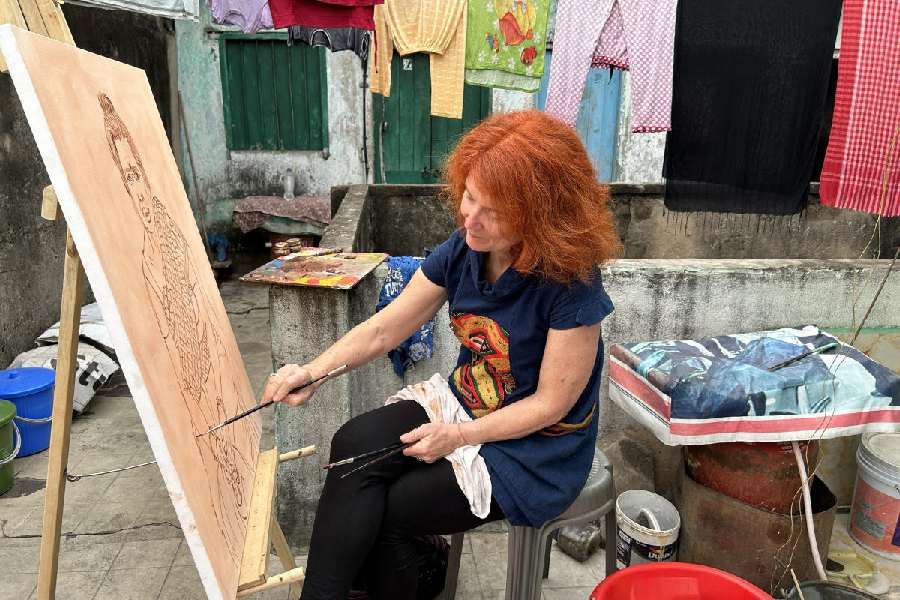People draw life lessons from the most unexpected of quarters. For American artist and painter Joan Marie Kelly, it has been the “invisible personas”, as she describes them in her book by the same name.
Her regular practice is to draw directly from life, so there she is out on the streets with her easel and canvas, painting individuals and groups.
She has painted wrestlers fighting in the mud pits in Benaras; lifeguards and pilgrims in Puri; and the women in the brothels of Calcutta.
“I love the way every- thing is not designated in this country,” said Kelly, who was in Calcutta for the better part of December, painting the those very sex workers whom she had first painted way back in 2008.

Portraits from then and now
It was a chance encounter that brought Kelly to the bylanes of Calcutta. In 2005, she joined Singapore’s Nanyang Technological University’s School of Art, Design and Media to teach as a senior lecturer.
To her dismay, Kelly found the Singaporeans to be very formal. No one would talk to others unless properly introduced.
“The work that I do as an artist needs to have a relationship to where I am, to the communities and the people around there. My work has always been about that. In Singapore everyone was so alien,” said Kelly.
And then one night as she was returning from a gallery opening, she decided to sit at a very informal café. Out of the academic environment, here she found the locals friendly and easy to talk to. “A man came along and introduced himself to me as John and said he was a pimp!” Kelly rolls her eyes. “Whoever introduces himself as a pimp!”
Soon enough, she retur- ned to that locality with her canvas and easel and John came along, introducing her as a famous artist and declaring that she would paint his women. Said Kelly, “That is how it all started, I started painting those sex workers who were mostly from India, Vietnam and China. This gave me the feel of the local culture. The paintings connected me to society.”
Shortly afterwards, while attending a conference on “Making Art History Glo-bal”, she was introduced to a gentleman from Calcutta, Bhaskar Mukhopadhyay. She said, “He was doing research on women in brothels. He invited me to come to Calcutta. He felt that if I drew the girls, he would get an opportunity to observe them, ask questions and find out about the dynamics of the brothel.”
But when she landed in the city, Mukhopadhyay was out of town, leaving a gentle-
man to pick her up, take her to a guesthouse and introduce her to a sex worker. From then on, Kelly was on her own, having a life-chan-ging experience as she drew the women.
The sex worker she was introduced to, Heena (name changed to protect privacy), had natural leadership skills. She organised women whom Kelly could paint, paying each Rs 500 for every sitting.
“The first year I just did the heads, about 20-25 of them. But I found that the heads weren’t telling the full story. Then I started doing these drawings with the brush,” said Kelly.
She came back in 2009 and this time she drew the full bodies. “A full body gives you a feel of who they are... the way they use their hands, how they decide to pose.”
While at it, Kelly came to know how life had dumped most of them at the brothel and how their poverty-stricken families would not take them back. Some, of course, were born there.
As an outsider, the complexity of the social order was beyond Kelly’s comprehension. But what touched her was the humanity bet-ween them.
“We would laugh a lot, sharing jokes. I paid Heena to cook for me and, boy, is
she an amazing cook! I was particularly impressed with the way this women’s community functioned. All the women were active workers then. So each would step out to take care of others’ kids. There were a lot of kids there,” Kelly reminisced.
The women made a deep impact on her.
Cut to the present. After so many years, why is Kel-ly back again, drawing
the same women, who have now retired?
“It wasn’t sudden at all,” said Kelly. “I had thought of them often and more so during the pandemic, when
I had wondered how they were making ends meet. I had even transferred some money into Heena’s bank account and had kept in touch with her all through.”
She added, “I was suddenly seriously thinking about my own survival, how I was going to survive when I didn’t have my job any longer. And I was thinking of these women more than ever before, the way they have fought life with the odds stacked against them. I felt the need to see them again, to draw inspiration from their lives, and observe the changes that time has wrought upon them.
Unlike the first time, now the women didn’t bother to dress up for Kelly in saris and bindis. Said Kelly, “Now, it’s a collective action, a network that sees them through. A network that helps them survive. And a pointer to me to stop worrying and get on with my life.”










